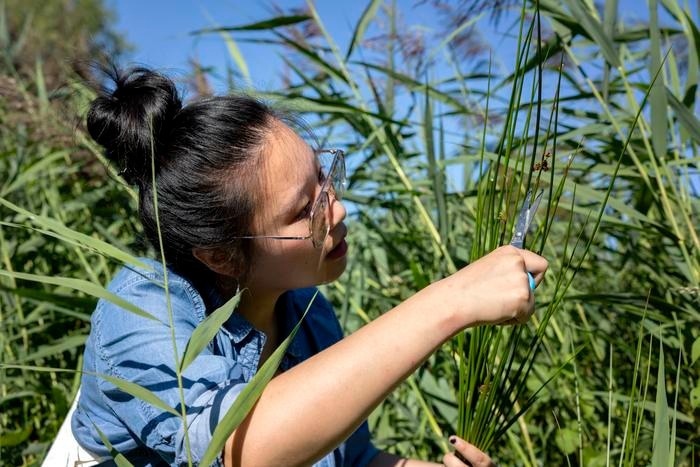Serendipity abounds throughout Qi Chen’s research story. She was chatting about the subjects of her classmates’ research studies with friends at the university’s Zernike campus during her first year of Ph.D. Chen informed them that she would be researching foam-like materials. A grass-like plant’s stem was casually peeled off by a friend, exposing its inside, which appeared to be an open and airy structure. He playfully suggested that Chen might want to go through it. After placing it in her backpack, she promptly forgot about it.
 Macromolecular chemist Qi Chen of the University of Groningen built a tiny sensor from a plant she harvested at the University Campus. Image Credit: Leoni von Ristok - University of Groningen
Macromolecular chemist Qi Chen of the University of Groningen built a tiny sensor from a plant she harvested at the University Campus. Image Credit: Leoni von Ristok - University of Groningen
Chen discovered the herb in her backpack over two years later. She had been attempting to generate power from bacteria by employing foamy materials as a living habitat. The results were unimpressive, so she decided to investigate this grass-like plant: soft rush (Juncus effusus L.), a common wetland weed.
Tiny Snowflakes
The structure of the soft rush stem consists of layers of interconnected stars, a bit like tiny snowflakes.
Qi Chen, Ph.D. Student, University of Groningen
These layers are placed on top of each other to form a structure that permits a large amount of air to flow through.
Chen added, “My samples were ultra-lightweight. Once, I left the samples uncovered and as I opened the lab door, the samples were blown away. It looked like it had snowed in the hallway.”
Many aquatic or wetland plants have aerenchyma—an open structure—in their interiors.
“The plant needs this open structure to breathe because with their roots in a wet environment, they need to take oxygen from the air and transport it through the stem,” Chen noted.
It turns out that this material is a fantastic substitute source for organic plant-based foams.
A Tiny Device to Put in Your Shoe
The distinctive form of the little snowflakes in the soft rush stem was also ideal for creating a nanogenerator: a tiny device that generates an electric charge that can be utilized as a sensor or an energy source.
A nanogenerator like this one could potentially make the present trend of increasingly smaller wearable electronics more sustainable by replacing batteries that end up in electronic waste.
Chen constructed a nanogenerator the size of a postage stamp, roughly one millimeter thick, alongside colleagues Wenjian Li and Feng Yan. It functions as a motion sensor.
You can put it in your shoe and when you walk, jump, or run, it releases a distinct signal that we can recognize.
Dina Maniar, Study Co-Author and Assistant Professor, Faculty of Science and Engineering, University of Groningen
The triboelectric effect, which causes a shock when a doorknob is touched after walking across the carpet, is the basis for this little gadget. It is made up of two tiny layers with rough edges. A separator keeps the two layers separate, but when pressed, friction between the layers develops an electric charge, similar to how an electric charge builds up when feet are shuffled on a carpet.
Maniar noted, “This enables us to convert movement into electrical signals.”
On the layers of the nanogenerator, the small snowflakes from the soft rush plant form a rough, foamy surface with numerous pores: ideal for excellent friction between the layers while remaining lightweight. This was another coincidental discovery: Chen had dropped some of her dissolved plant material on aluminum foil and had neglected to pick it up. The water evaporated, leaving a thin layer with a rough surface reminiscent of small snowflakes.
It Really Can be Called Sustainable
For years, scientists have been attempting to create foam-like polymers from plant cellulose.
Usually, a lot of resources go into extracting cellulose, breaking down the structure as it was. Then, a lot of resources go into producing the desired structure for new materials.
Katja Loos, Study Co-Author and Professor, Applied Chemistry, University of Groningen
By removing the stem and dissolving it in a simple combination, Chen was able to maintain the building blocks—the little ‘snowflakes’—of the soft rush insides.
She stated, “So, we can really call it sustainable.”
This technique used very little energy and no oil-based fossil resources. Chen is also working on different applications, including using the soft rush snowflakes as part of a battery and to remove contaminants from water.
Chen observed that the local municipality had just removed a lot of the soft rush growth.
Chen concluded, “Now I just have to cycle a bit further to get it. ‘In our lab, it’s not a weed; it’s a valuable resource.”
Journal References:
Chen, Q., et al. (2023) Aerenchyma tissue of Juncus effusus L.: a novel resource for sustainable natural cellulose foams. Cellulose. doi:10.1007/s10570-023-05453-9
Chen, Q., et al. (2023) Lightweight Triboelectric Nanogenerators Based on Hollow Stellate Cellulose Films Derived from Juncus effusus L. Aerenchyma. Advanced Functional Materials. doi:10.1002/adfm.202304801